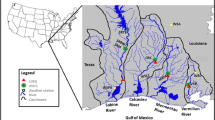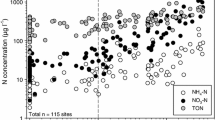Abstract
Alterations to the lower Mississippi River-floodplain ecosystem to facilitate commercial navigation and to reduce flooding of agricultural lands and communities in the historic floodplain have changed the hydrologic regime. As a result, the flood pulse usually has a lower water level, is of shorter duration, has colder water temperatures, and a smaller area of floodplain is inundated. Using average hydrologic conditions and water temperatures, we used established nitrogen and phosphorus processes in soils, an aquatic ecosystem model, and fish bioenergetic models to provide approximations of nitrogen and phosphorus flux in Mississippi River flood waters for the present conditions of a 2-month (mid-March to mid-May) flood pulse and for a 3-month (mid-March to mid-June), historic flood pulse. We estimated that the soils and aquatic biota can remove or sequester 542 and 976 kg nitrogen ha−1 during the present and historic hydrologic conditions, respectively. Phosphorus, on the other hand, will be added to the water largely as a result of anaerobic soil conditions but moderated by biological uptake by aquatic biota during both present and historic hydrologic conditions. The floodplain and associated water bodies may provide an important management opportunity for reducing downstream transport of nitrogen in Mississippi River waters.
Similar content being viewed by others
Literature Cited
Bajer, P. G., G. W. Whitledge, and R. S. Hayward. 2004. Widespread consumption-dependent systematic error in fish bioenergetics models and its implications. Canadian Journal of Fisheries and Aquatic Sciences 61: 2158–67.
Baker, J. A., K. J. Killgore, and R. L. Kasul. 1991. Aquatic habitats and fish communities in the lower Mississippi River. Reviews in Aquatic Sciences 3: 313–56.
Biggs, J. F., R. A. Smith, and M. J. Duncan. 1999. Velocity and sediment disturbance of periphyton in headwater streams: biomass and metabolism. Journal of the North American Benthological Society 18: 222–41.
Bohn, H. L., B. L. McNeal, and G. A. O’Conner. 2001. Soil Chemistry, third edition. John Wiley and Sons, New York, NY, USA.
Brady, N. C. and R. R. Weil. 2008. The Nature and Properties of Soils, fourteenth edition. Pearson, Columbus, OH, USA.
Carlander, K. D. 1969. Handbook of Freshwater Fishery Biology. Volume one. Iowa State University Press, Ames, IA, USA.
Cobb, S. P., C. H. Pennington, J. A. Baker, and J. E. Scott. 1984. Fishery and ecological investigations of main stem levee borrow pits along the lower Mississippi River. U.S. Army Corps of Engineers, Mississippi River Commission, Vicksburg, MS, USA.
Coveney, M. F., D. L. Stites, E. F. Lowe, L. E. Battoe, and R. Conrow. 2002. Nutrient removal from eutrophic lake water by wetland filtration. Ecological Engineering 19: 141–59.
Dantas, M. C. and J. L. Attayde. 2007. Nitrogen and phosphorus content of some temperate and tropical freshwater fishes. Journal of Fish Biology 70: 100–08.
Eggleton, M. A. 2001. Catfish feeding ecology and bioenergetics in a large river-floodplain ecosystem. Ph.D. Dissertation. Mississippi State University, Mississippi State, MS, USA.
Fisher, J. and M. C. Acreman. 2004. Wetland nutrient removal: a review of the evidence. Hydrology and Earth System Sciences 8: 673–85.
Forshay, K. J. and E. H. Stanley. 2005. Rapid nitrate loss and denitrification in a temperate river floodplain. Biogeochemistry 75: 43–64.
Furch, K. and W. J. Junk. 1993. Seasonal nutrient dynamics in an Amazonian floodplain lake. Archiv für Hydrobiologie 128: 277–85.
Galat, D. L., L. H. Fredrickson, D. D. Humburg, K. J. Bataille, J. R. Bodie, J. Dohrenwend, G. T. Gelwicks, J. E. Havel, D. L. Helmers, J. B. Hooker, J. R. Jones, M. F. Knowlton, J. Kubisiak, J. Mazourek, A. C. McColpin, R. B. Renken, and R. D. Semlitsch. 1998. Flooding to restore connectivity of regulated, large-river wetlands. BioScience 48: 721–33.
Gambrell, R. P. and W. H. Patrick. 1978. Chemical and microbiological properties of anaerobic soils and sediments. p. 375–423. In D. D. Hook and R. M. M. Crawford (eds.) Plant Life in Anaerobic Environments. Ann Arbor Science, Ann Arbor, MI, USA.
Gergel, S. E., S. R. Carpenter, and E. H. Stanley. 2005. Do dams and levees impact nitrogen cycling? Simulating the effects of flood alterations on floodplain denitrification. Global Change Biology 11: 1352–67.
Goolsby, D. A. and W. A. Battaglin. 2000. Nitrogen in the Mississippi Basin—estimating sources and predicting flux to the Gulf of Mexico. U.S. Geological Survey, Kansas Water Science Center, Lawrence, KS, USA.
Graham, K. 1999. A review of the biology and management of blue catfish. American Fisheries Society Symposium 24: 37–49.
Gutreuter, S., A. D. Bartels, K. Irons, and M. B. Sandheinrich. 1999. Evaluation of the flood-pulse concept based on statistical models of growth of selected fishes of the upper Mississippi River system. Canadian Journal of Fisheries and Aquatic Sciences 56: 2282–91.
Hansen, M. J., D. Biosclair, S. B. Brandt, S. W. Hewett, J. F. Kitchell, M. C. Lucas, and J. J. Ney. 1993. Applications of bioenergetics models to fish ecology and management: where do we go from here? Transactions of the American Fisheries Society 122: 1019–30.
Hanson, P. C., T. B. Johnson, D. E. Schindler, and J. F. Kitchell. 1997. Fish Bioenergetics 3.0. University of Wisconsin-Madison Center for Limnology and Wisconsin Sea Grant Institute, Madison, WI, USA.
Helmer, C. and S. Kunst. 1998. Simultaneous nitrification/denitrification in an aerobic biofilm system. Water Science and Technology 37: 183–87.
Hillebrand, H. and M. Kahlert. 2001. Effect of grazing and nutrient supply on periphyton biomass and nutrient stoichiometry in habitats of different productivity. Limnology and Oceanography 46: 1881–98.
Junk, W. J., P. B. Bayley, and R. E. Sparks. 1989. The flood pulse concept in river-floodplain ecosystems. p. 110–127. In D. P. Dodge (ed.) Proceedings of the International Large Rivers Symposium. Canadian Journal of Fisheries and Aquatic Sciences Special Publication 106, Ottawa, ON, Canada.
Lindau, C. W., R. D. DeLaune, and J. H. Pardue. 1994. Inorganic nitrogen processing and assimilation in a forested wetland. Hydrobiologia 277: 171–78.
Lowery, D. R., M. P. Taylor, R. L. Warden, and F. H. Taylor. 1987. Fish and benthic communities of eight lower Mississippi River floodplain lakes. Lower Mississippi River Environmental Program Report 6. Mississippi River Commission, Vicksburg, MS, USA.
Minckley, W. L., J. E. Johnson, J. N. Rinne, and S. E. Willoughby. 1970. Foods of buffalofishes, genus Ictiobus, in central Arizona reservoirs. Transactions of the American Fisheries Society 99: 333–42.
Mitchell, D. S. 1994. Floodplain wetlands of the Murray-Darling Basin: management, issues and challenges. p. 1–5. In T. Sharly and C. Huggin (eds.) Murray-Darling Basin Floodplain Wetlands Management. Murray-Darling Commission, Canberra, ACT, Australia.
Mitsch, W. J., J. W. Day, Jr., J. W. Gilliam, P. M. Groffman, D. L. Hey, G. W. Randall, and N. Wang. 2001. Reducing nitrogen loading to the Gulf of Mexico from the Mississippi River Basin: strategies to counter a persistent ecological problem. BioScience 51: 373–88.
Mitsch, W. J. and J. G. Gosselink. 1986. Wetlands. Van Nostrand Reinhold, New York, NY, USA.
Park, R. A. and J. S. Clough. 2006. Aquatox. EPA release 2.2. Environmental Protection Agency, Washington, DC, USA.
Patrick, W. H. Jr and R. D. Delaune. 1972. Characterization of the oxidized and reduced zones in flooded soil. Soil Science Society of America Proceedings 36: 573–76.
Rabalais, N. N., R. E. Turner, and D. Scavia. 2002. Beyond science into policy: Gulf hypoxia and the Mississippi River. BioScience 52: 129–42.
Rissotto, S. P. and R. E. Turner. 1985. Annual fluctuations in abundance of the commercial fisheries of the Mississippi River and tributaries. North American Journal of Fisheries Management 5: 557–74.
Ross, S. T. 2001. The Inland Fishes of Mississippi. Mississippi Department of Wildlife, Fisheries and Parks, Jackson, MS, USA.
Rudstam, L. G., F. P. Binkowski, and M. A. Miller. 1994. A bioenergetic model for analysis of food consumption patterns of bloater in Lake Michigan. Transactions of the American Fisheries Society 123: 344–57.
Rutherford, D. A., W. E. Kelso, C. F. Bryan, and G. C. Constant. 1995. Influence of physicochemical characteristics on annual growth increments of four fishes from the lower Mississippi River. Transactions of the American Fisheries Society 124: 687–97.
Schaus, M. H., M. J. Vanni, and T. E. Wissing. 2002. Biomass-dependent diet shifts in omnivorous gizzard shad: implications for growth, food web, and ecosystem effects. Transactions of the American Fisheries Society 131: 40–57.
Schramm, H. L., Jr. 2004. Status and management of fisheries in the Mississippi River. p. 301–33. In R. Welcomme and T. Petr (eds.) Proceedings of the Second International Symposium on the Management of Large Rivers for Fisheries Volume 1. RAP Publication 2004/16, FAO Regional Office for Asia and the Pacific, Bangkok, Thailand.
Schramm, H. L., Jr. and M. A. Eggleton. 2006. Applicability of the flood-pulse concept in a temperate floodplain river ecosystem: thermal and temporal components. River Research and Application 22: 543–53.
Schramm, H. L., Jr., M. A. Eggleton, and R. M. Mayo. 2000. Habitat conservation and creation: invoking the flood-pulse concept to enhance fisheries in the lower Mississippi River. Polish Archives for Hydrobiology 47: 45–62.
Schramm, H. L., Jr., M. A. Eggleton, and R. B. Minnis. 1999. Spatial analysis of floodplain habitat critical to lower Mississippi River fishes. Mississippi Cooperative Fish and Wildlife Research Unit, Mississippi State, MS, USA.
Sereda, J. M., J. J. Hudson, W. D. Taylor, and E. Demers. 2007. Fish as sources and sinks of nutrients in lakes: direct estimates, comparison with plankton and stoichiometry. Freshwater Biology 53: 278–89.
Stanford, G., S. Dzienia, and R. A. Vander Pol. 1975. Effect of temperature on denitrification rate in soils. Soil Science Society of America Proceedings 39: 867–70.
Tilman, D., S. S. Kilham, and P. Kilham. 1982. Phytoplankton community ecology: the role of limiting nutrients. Annual Reviews in Ecology and Systematics 13: 349–72.
Tockner, K., D. Pennetzdorfer, N. Reiner, F. Schiemer, and J. V. Ward. 1999. Hydrological connectivity, and the exchange of organic matter and nutrients in a dynamic river-floodplain system (Danube, Austria). Freshwater Biology 41: 521–35.
Turner, F. T. and W. H. Patrick, Jr. 1968. Chemical changes in waterlogged soils as a result of oxygen depletion. Transactions of the 9th International Congress of Soil Science 4: 53–56.
USGS (United States Geological Service). 2008. Summary Statistics for NASQAN Data—Mississippi Basin 1996–2005: Mississippi River at St. Francisville, Louisiana (07373420). [Online]. Available at http://water.usgs.gov/nasqan/data/statsum/st.francis.html (Verified 19 Feb. 2008)
Walker, T. W. 2002. Soil fertility management of precision-leveled rice fields in the Mississippi Delta. Ph.D. Dissertation, Mississippi State University, Mississippi State, MS, USA.
Ward, J. V. and J. A. Stanford. 1995. Ecological connectivity in alluvial river ecosystems and its disruption by flow regulation. Regulated Rivers: Research and Management 11: 105–19.
Wetzel, R. G. 1993. Microcommunities and microgradients: linking nutrient regeneration, microbial mutualism, and high sustained aquatic primary production. Aquatic Ecology 27: 3–9.
White, J. R. and K. R. Reddy. 2003. Nitrification and denitrification rates of Everglades wetland soils along a phosphorus-impacted gradient. Journal of Environmental Quality 32: 2436–43.
Yako, L. A., J. M. Dettmers, and R. A. Stein. 1996. Feeding preferences of omnivorous gizzard shad as influenced by fish size and zooplankton density. Transactions of the American Fisheries Society 125: 753–59.
Author information
Authors and Affiliations
Corresponding author
Additional information
The Unit is jointly sponsored by the U.S. Geological Survey, Mississippi State University, the Mississippi Department of Wildlife, Fisheries and Parks, and the Wildlife Management Institute.
Rights and permissions
About this article
Cite this article
Schramm, H.L., Cox, M.S., Tietjen, T.E. et al. Nutrient dynamics in the lower Mississippi River floodplain: Comparing present and historic hydrologic conditions. Wetlands 29, 476–487 (2009). https://doi.org/10.1672/08-62.1
Received:
Accepted:
Issue Date:
DOI: https://doi.org/10.1672/08-62.1




